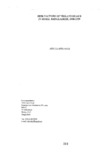Risk factors of violent death in rural Bangladesh, 1990-1999
Date
2002Publisher
BRAC Research and Evaluation Division (RED)Author
Hadi, AbdullahelMetadata
Show full item recordCitation
Hadi, A. (2002). Risk factors of violent death in rural Bangladesh, 1990-1999. Research Reports (2002): Social Studies, Vol – XXX, 368–385.Abstract
The study attempts to improve our understanding about the prevalence and
determinants of violent death in rural Bangladesh. Data came from the demographic and health
surveillance system of BRAC covering a population of nearly 62,000 in 70 villages in J 0 districts
of the country. A standard verbal autopsy procedure was used to identify the causes of death. All
non-disease specific deaths due to homicide, accident, drowning and suicide were considered
violent death in this study.
Findings reveal that the violent death rate was 28.3 per 100,000 persons per year during
the 1990-1999. Drowning and homicide were the leading causes of death followed by the traffic
accident and suicide. Significant sociodemographic differentials in violent death existed. The
death rate was much higher among the «10 year old) children than the young adults and the old
«0.01). Men were significantly more likely to die than women from aberrant causes. The violent
death was higher among the poor than the rich, illiterates than the educated and among the
Muslims than non-Muslims. When all predictors were considered together, the probability to
become the victim of violent death was 61.2 per 100,000 if the person was very young, male, poor,
illiterate and Muslim. The paper concludes that the public health program should consider the
appropriate mechanisms to prevent many avoidable events of death in rural Bangladesh.

